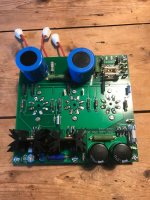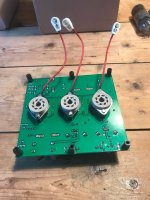Hello, everyone. I was wondering if anyone here has any experience building a regulated power supply using EL36 tubes and a 5AR4 rectifier, as in the Brinkmann Ront II PSU? The output of that supply is DC 24.5V, approximately.
There is very little information on the web about this PSU, other than it uses the 5AR4 as a rectifier to supply 80V to a paralleled pair of EL36 tubes that are used as series pass regulators. There are some common mode chokes, and some solid state bits that control the tubes- creating a reference voltage, and receiving feedback to set the output voltage precisely. I have a good idea on how to build it, but figured I would ask up here first.
There is very little information on the web about this PSU, other than it uses the 5AR4 as a rectifier to supply 80V to a paralleled pair of EL36 tubes that are used as series pass regulators. There are some common mode chokes, and some solid state bits that control the tubes- creating a reference voltage, and receiving feedback to set the output voltage precisely. I have a good idea on how to build it, but figured I would ask up here first.
I am struggling to think of a good reason why anyone would build a 24V DC supply using valves, unless they wanted to heat the room too. I can think of a couple of bad reasons.
I am struggling to think of a good reason why anyone would build a 24V DC supply using valves,
Easy: bottom line.
Anything with valves in it commands a much higher sales price than the equivalent (or better, most likely) solid state version.😉
Jan
'At first blush, it seems a crazy idea to use vacuum tubes for a low-voltage turntable power supply. So why do we do it? We found that the vacuum in the rectifier tubes not only isolates their plates from the cathodes, but also the power line from the drive circuitry...'
See, it's obvious once you've got the proper explanation. I thought this was an audio forum. Don't you guys know anything?
See, it's obvious once you've got the proper explanation. I thought this was an audio forum. Don't you guys know anything?
'At first blush, it seems a crazy idea to use vacuum tubes for a low-voltage turntable power supply. So why do we do it? We found that the vacuum in the rectifier tubes not only isolates their plates from the cathodes, but also the power line from the drive circuitry...'
See, it's obvious once you've got the proper explanation. I thought this was an audio forum. Don't you guys know anything?



I may have to eat crow, but why not tubes? Being practical isn't always a lot of fun. It's a hobby, right?
You could do a killer job with tubes, but it would be something like a PWM.
What really cracks me up the most is that the sales pitch for the Roent II is galvanic isolation via the pass tubes, but the docs for the Roent I indicate it didn't use pass tubes but tried to regulate via tubes. Now THAT is when the marketing department rules!
I say why NOT? Vacuum tube rectifiers produce a much smoother output- less switching noise, and the Ront doesn't run very hot at all. The direct drive turntable motor demands at most 12 watts of power during start up, so the output stage doesn't have all that much to do…
If I was interested in solely practical solutions for my audio system, I wouldn't bother with analog at all- just run a big server over a set of powered speakers. Of course, then I'd probably stop listening to music altogether.
If I was interested in solely practical solutions for my audio system, I wouldn't bother with analog at all- just run a big server over a set of powered speakers. Of course, then I'd probably stop listening to music altogether.
I say why NOT?
I must agree. So to the already given answers, we should add: 'because we can'.
We often unconsciously want to give practical and factual answers, but this is certainly also a valid one.
Jan
It appears trivial to build something similar, although how exactly a pair of triode strapped EL36 would supply the supposed 500mA startup current is not quite clear. Maybe the concept works with Brinkman's motor, but my impression of the Maxon i use is that the tt sounds much better with a really beefy PS. Consequently mine uses excessively oversized transformer, chokes and filtering caps to power a 3-terminal regulator. Even better results can be achieved with a 5-10A/h lithium batteries. None of the current limited supplies i tried sounded right.
I don't think electric motors are too bothered by "switching noise" - they have considerable rotational inertia.Corvus corax said:Vacuum tube rectifiers produce a much smoother output- less switching noise
However, my question has been answered: the OP wants to do it simply because it is possible. Good enough for DIY, provided sound quality is not too high a priority. Commercial versions may have different reasons, despite their 'story', as suggested by Jan and others.
If I was interested in solely practical solutions for my audio system, I wouldn't bother with analog at all- just run a big server over a set of powered speakers. Of course, then I'd probably stop listening to music altogether.
Guess you don't really like music then, 'cos if I had to go back to AM radio, it wouldn't stop me.
😛
My point is, that I rarely look at the practicalities of audio systems as a deciding factor in either building or using my personal systems. I've actually HEARD the Ront and the standard DC supplies on a TT, and preferred the Ront. Having said that, I cant afford the Ront right now (turntable/ tonearm purchase), and I work with tubes EVERY DAY, so I figured I'd ask if anyone had some information on the best course to get my experiments started.
I can easily figure this out on my own, but if I can cut the design cycle time down, I will always do whatever I can to achieve that goal. My time is valuable, and I haven't a lot of time to fart around in the dark making expensive mistakes.
I have some output tubes on the way, and I will dig around for the 5AR4 in my junk box. After that, I guess I'll throw a regulated supply together using a sample circuit I dug up from Audio Xpress one day, with the values adjusted to take into account the differences in desired output voltage and current. Better through in some protection diodes to keep the TT safe if I lose a tube…
My point is, that I rarely look at the practicalities of audio systems as a deciding factor in either building or using my personal systems. I've actually HEARD the Ront and the standard DC supplies on a TT, and preferred the Ront. Having said that, I cant afford the Ront right now (turntable/ tonearm purchase), and I work with tubes EVERY DAY, so I figured I'd ask if anyone had some information on the best course to get my experiments started.
I can easily figure this out on my own, but if I can cut the design cycle time down, I will always do whatever I can to achieve that goal. My time is valuable, and I haven't a lot of time to fart around in the dark making expensive mistakes.
I have some output tubes on the way, and I will dig around for the 5AR4 in my junk box. After that, I guess I'll throw a regulated supply together using a sample circuit I dug up from Audio Xpress one day, with the values adjusted to take into account the differences in desired output voltage and current. Better through in some protection diodes to keep the TT safe if I lose a tube…
Hello. Did you ever build a 24v PS for your Brinkmann TT? I have a Bardo and would appreciate any info you can share regarding building a 24v PS.
Thanks.
Thanks.
Once I bought a highly-reviewed cd player. It sounded like poo and did stop me from cds at least, until I fixed the situation.Guess you don't really like music then, 'cos if I had to go back to AM radio, it wouldn't stop me.
Seems like the tube supply is very soft under load. A small transformer or series resistor 22 to 100 ohms would do the same thing. Less instant torque from the motor to maintain speed would be audible. I lowered the regulator voltage on my LAB 500 TT for this reason.
Hey Corvus
Go for it if only just to show it can be done. Its not always about staying inside the circle of your audi emblem. No offense meant to Audi owners... its the only car brand that I could think of having said set of all points in a plane at a given distance from a given point
Go for it if only just to show it can be done. Its not always about staying inside the circle of your audi emblem. No offense meant to Audi owners... its the only car brand that I could think of having said set of all points in a plane at a given distance from a given point
- Home
- Amplifiers
- Power Supplies
- Low voltage tube based supply for turntable?


